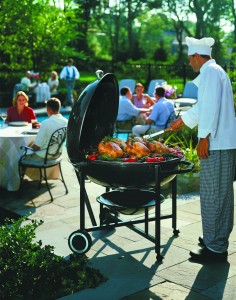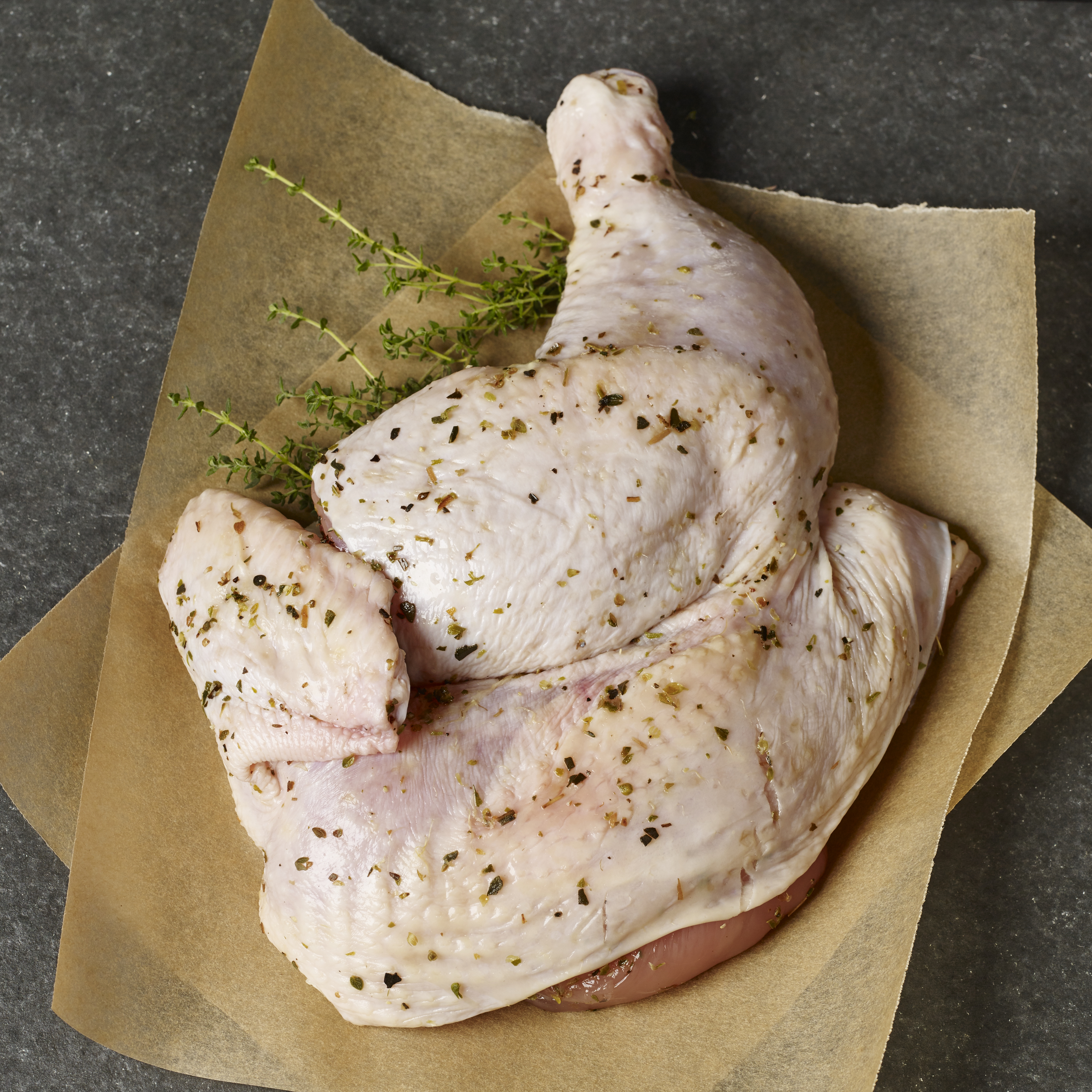Is there anything better on a hot summer day than driving in your car with the windows open and getting hit with the stop-you-in-your-tracks aroma of chicken being barbecued somewhere?
Whether in someone’s backyard, in a church parking lot, at the local firehouse, in a park, or on the beach, every one of them aspires to golden-charred finish. Yet the recipes and methods used to get there burst into myriad variations—hardly two alike.
Let your nose lead the way. The olfactory wallop of grilling chicken is unmistakable and seems to travel farther and linger longer than other food fragrances of summer. It draws you in like a siren’s song, and you can’t get the taste out of your thoughts until you surrender to your own plate of barbecued chicken accompanied by your favorite sides.

©2012 Weber-Stephen Products LLC. Used with permission.
Selecting Your Bird
Whole or Pieces?
Your first decisions are: How much and how big? Are you going to grill whole chickens, splits, quarters, or parts?
One of the biggest challenges of cooking whole chickens is making sure that every piece or part is cooked to a safe internal temperature: 165°F at the breast and 185°F at the thigh. An instant-read thermometer is critical to ensuring the right degree of doneness. Further evidence comes from pricking the skin and flesh to see that the juices run clear.
If you are grilling bone-in parts, give boneless breasts and thighs a head start of 10 to 15 minutes on the heat before adding drumsticks, then wait another 5 to 10 minutes before adding the wings. From start to finish you’ll need about 45 minutes of grilling time, depending on how hot you are running your fire.
Bone-In or Boneless?
When cooking chicken on the grill, bone-in cuts—like other meats—taste better. The bones impart the slightest sweetness and extra flavor. However, bone-in chicken takes longer to barbecue. On the other hand, boneless cuts cook more quickly and offer convenient no-fuss, no-muss serving and cutting. When it comes to bone-in or boneless, it’s really a matter of preference.
Cooking Methods
Grill-Roasting
Frying chickens (3 to 4 pounds) or roasting chickens (5 to 7 pounds) are ideal for grill-roasting whole.
To barbecue, or grill-roast, a whole chicken, set up your gas or charcoal grill for indirect-heat cooking. Coat the skin with olive oil, salt, and pepper, and a dry rub, if you like. Use a drip pan to catch the chicken fat. Keep the pan about half full of water, wine, beer, stock, or any combination of liquids. No need to sear the chicken. Keep your running temperature at about 350 to 375°F.
For a smoky flavor, use chunks, chips or pellets, depending on the type of grill you have, and the intensity of the smokiness you desire. Woods like hickory and mesquite create heavy smoke flavors, while fruit woods add lighter flavor notes that often work well in combination with heavier wood flavors. See our article on cooking with smoke.
Beer Can
Another method of barbecuing a whole chicken is the beer-can method. Again, use indirect heat. Fryers are also the best choice for this method. Coat the chicken with olive oil and a dry rub. Position the chicken with the neck opening upward and slide down over a half-full open can of beer on the grill grid, making sure that it is stable resting on the beer can and the chicken’s legs. Over moderate heat, the beer will steam the chicken from the inside and permeate the meat with its unique flavor. Try different types of beers for different resulting flavors. There are also specialty pans available that achieve the same effect, but allow you to use your choice of liquid, such as wine or stock.
Tuscan-Style
Try barbecuing a whole chicken Tuscan-style, where the chicken’s backbone is removed and it is grilled flat on each side over indirect heat. Searing the chicken first is optional. Once again, olive oil, salt, and pepper are the base, but experiment with flavors of your choice, including garlic—fresh or powder—rosemary, thyme, five-spice powder for an Asian bent, or spicy chile blends. Anything you desire is possible.
Tuscan-style is one step removed from grilling chicken halves, also known as splits or split broilers. One way to even up the cooking time between breast and leg/thigh is to use splits that have the breast bones removed, as in Lobel’s Seasoned Split Chickens. Without the bones slowing down the cooking process, white and dark meat reach the same degree of doneness at the same time. With the bones left in, you’ll need about 45 minutes on the grill, whereas semi-boneless splits will be done in about 30 minutes, depending on your fire.
 Lobel's Seasoned Split Chickens
Lobel's Seasoned Split Chickens
Cornell Recipe
So many regions have their own special style of marinade. One classic from Upstate New York is known as the Cornell Chicken Barbecue Sauce.
The recipe was developed in the 1950s at Cornell University by Dr. Robert C. Baker, a professor of animal science, who initially started out trying to develop a market for smaller chickens than those that were common for the time.
From 4- to 5-pound birds to about 2- to 3-pound birds, the question arose: What to do with these smaller, more tender birds? Dr. Baker’s answer was: backyard barbecue and a marinade of oil, vinegar, poultry seasoning, egg, and black pepper.
Ingredients
2 cups vinegar
1 cup oil
1 egg
3 tablespoons salt
1 tablespoon poultry seasoning
Black pepper to taste
Preparation
Put ingredients into a blender and blend until smooth. Marinate chicken in half the sauce for 6 to 8 hours or overnight. Discard the marinade. Baste while cooking with the remaining half of the sauce.
Do you look forward to chicken BBQ every summer? What’s your favorite style of chicken BBQ? Does it taste better homemade or from your local church or fire-hall fundraiser? Are you planning on chicken BBQ for Father’s Day of July 4th this year?



Leave Your Response